Ferrari takes back-to-back wins at Le Mans 2024 in epic race
Ferrari prevails again after an intense rain-hit 2024 Le Mans 24 Hours, making it back-to-back victories after following its 2023 triumph
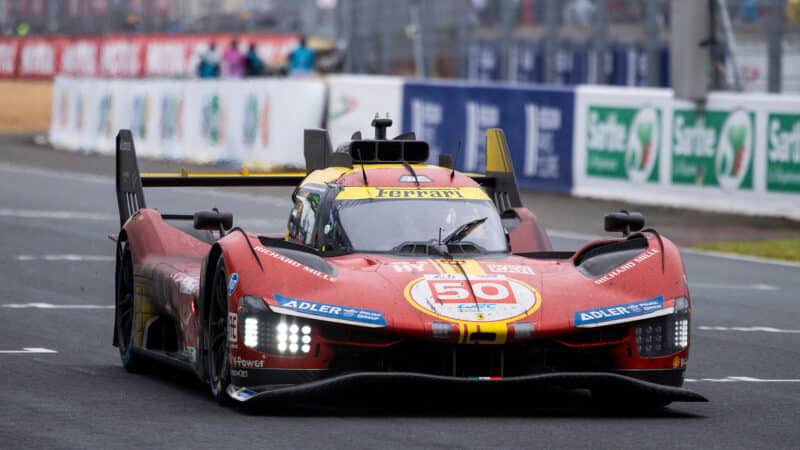
The No50 Ferrari came through a treacherous and tough race to prevail
The competition was bigger. It was stronger. And the weather threw its fair share of grenades, but Ferrari once more ended on top at the 2024 Le Mans 24 Hours with a second successive victory that was justified by its drivers’ virtuoso performances and a nerve-wracking final hour.
The field of 23 Hypercars battling for overall victory was the largest in modern times, and Ferrari was downplaying its chances ahead of the race.
But from the beginning, the No50 car of Nicklas Nielsen, Antonio Fuoco and Miguel Molina speared to the front, overtaking the Porsche polesitter on the first lap.
That storming start was a sign of the result to come, and although the winning margin was just 14 seconds after 24 hours, it was still decisive, after second-placed Toyota had called off the chase, unable to catch the rapid race leader.
Margins were tight throughout the race as, time and again, one of the three Ferrari 499P Hypercars would hit the front and pull out a lead, only to be hauled back by a series of safety cars that bunched the field up and effectively reset the race.
There were rivers running across the circuit in heavy rain, then intermittent showers; a safety car period that lasted more than four hours; even a stray dog on track. But the crew of the No50 Ferrari proved surefooted at each challenge.
When the opportunity came on Sunday morning, a series of rapid stints from its homegrown drivers saw the No50 car build an advantage, only for a failed door catch to jeopardise its chances in the final two hours.
The team was forced to repair it, in the process ripping up its carefully calculated pitstop schedule. The knock-on effect was that Nicklas Nielsen had to make a tank of fuel last a 51-minute final stint, when 45min would be more typical. In addition, he was being hunted down by the No7 Toyota, that had set the fastest lap and was quickest over much of the circuit.
Nielsen didn’t just survive, his pace was strong enough that Toyota told Jose Maria Lopez to give up the pursuit and focus on bringing the car home.
“It was an amazing race!” said Fuoco, whose pace on Sunday morning after the final safety car was the foundation for victory. “We were a bit afraid at the end of the day with the door but I think we did an amazing job through throughout the race.
“We had really good pace and during the race you just put everything together. The conditions were very tricky: damp and wet. All our three drivers we did an amazing job. I did a really good job this morning and put the car on top and then left it to Miguel and Nick in really tricky conditions.
“I think it means that we deserve it this year.”
The sister No51 Ferrari which won last year, came home in third, almost 40 seconds behind. One of its drivers, Antonio Giovinazzi, said it had been one of the toughest races in his career, while others described the changeable conditions, lengthy safety car periods and close competitions as stressful and tense.
“It wasn’t easy at times,” said his team-mate James Calado. “We made some wrong decisions, we were always on the back foot. But we kept pushing. We didn’t give up and a podium is a great result.”
The top three were followed by cars from Porsche and Cadillac, which showed pace to win, but couldn’t sustain the challenge.
Ferrari’s factory cars were also challenged by the yellow No86 customer Hypercar from AF Corse, but it retired with an apparent electrical issue. Other potential rivals hit trouble too: both Alpines were eliminated with engine failure on Saturday, and both BMW Hypercars crashed — one after being tagged by Robert Kubica in the AF Corse Ferrari.
Toyota had its own problems too. The No7 car had sensor issues that led it to run slowly for cettain laps, as well as two punctures, which also ruined its pitstop plans.
And so, the final reckoning came down to the leading Ferrari’s ability to stretch its
From the moment that France World Cup winner Zinedane Zidane waved the Tricolor to signal the start of the race, the fight for the lead was intense.
A visibly committed Kevin Estre had put the No6 Penske Porsche on pole on Thursday evening, ahead of the No3 Cadillac, but it was the Ferrari duo on the second row that set out in hot pursuit of Laurens Vanthoor in the No6 car; the fourth-placed No 50 of Nicklas Nielsen surging into second and taking the lead on the first lap.
It was soon joined by its No51 sister, as both Ferraris showed the straight-line pace that would keep them at the sharp end throughout the race.
The Porsche was still keeping close, with strong pace in the high-speed corners, as was Cadillac. And Toyota was gradually making its way up the field from 11th and 23rd on the grid. Car No7 had been consigned to the back of the Hypercar pack after Kamui Kobayashi crashed in qualifying and stopped the session, causing his lap times to be deleted.
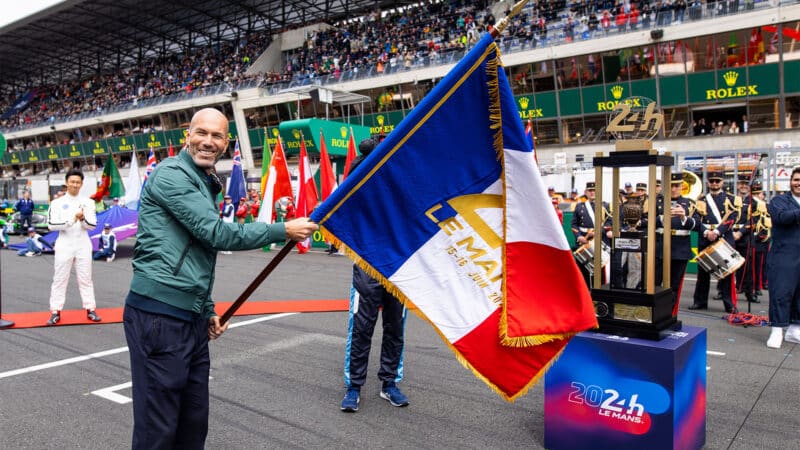
Zidane gets into the spirit of things
DPPI
BMW topped that session with its No15 car, but it gave a hint of what was to come in the first 20min when Marco Wittmann span and hit the barrier.
Close competition in all categories brought some eye-opening moments as the first cars were lapped; the battling hypercars suddenly having to contend with a tightly-packed field of fighting LMGT3s.
It was quickly clear that the pre-race uncertainty over which manufacturer was favourite to win would not be resolved in the early hours. Vanthoor took the lead after Ferrari pitstops, then Nielsen returned to the front.
By the end of the first hour, five seconds covered the top seven places, with Toyota in the top four.
In contrast Porsche customer team Proton was having a nightmare start to the race, with a door closing issue — a repeat of the problem that it had at the previous WEC round in Spa — that left it two laps down and out of contention after the first hour, but behind the top three sat Sébastien Bourdais in the No3 Cadillac, Sébastien Buemi in the No8 Toyota and Charles Milesi in the No35 Alpine fighting for third place, followed by Robert Kubica in the third yellow-liveried No83 AF Corse Ferrari.
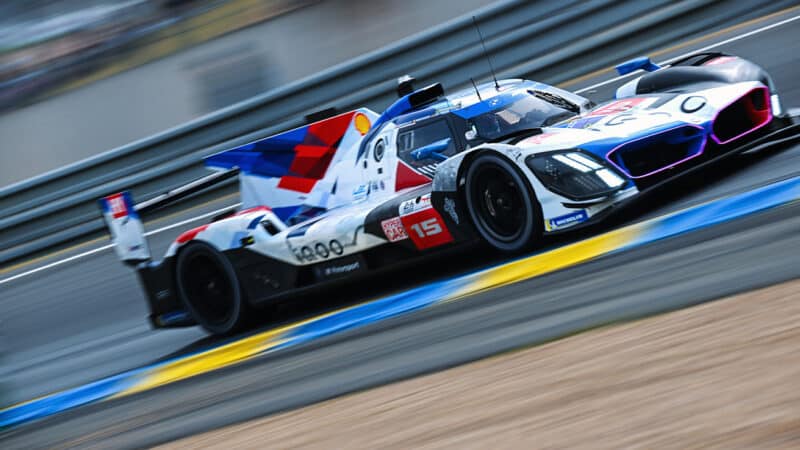
BMW had a trying race
Rain was always going to play its part this weekend, and the first shower began at 5.30pm local time, sending the Toyotas, Alpines and Cadillacs into the pits for wet tyres.
Ferrari split its strategy, pitting the No51 but leaving the No50 out on slicks, along with the No83 Ferrari, as well as two of the Porsches. Staying out was the right decision: the wet-shod runners had to return to the pits for slicks three laps later.
The No20 BMW stayed on slicks, but to no avail. Robin Frijns lost it on at kerb at Ford Chicane, crashed and had to limp round for an entire lap before getting back to his garage, where his car would remain for the rest of the race.
Shaken up by the rain, the front of the field now had Robert Kubica in the customer No83 Ferrari battling with Nielsen in the No50 factory effort, ahead of the No5 Porsche.
That only lasted until Nielsen pitted, swapping places with Antonio Fuoco in a lengthy stopped. Combined with a delay through a Dunlop Chicane slow zone caused by Thomas Flohr’s crash in the LMGT3 No54 Ferrari 296. Fuoco now sat more than 40sec behind race leader Kubica, with the No5 Porsche and No8 Toyota in between.

Lamborghini’s were solid., but lacked pace
Lamborghini’s Hypercars had stayed on slicks during the earlier shower and briefly featured near the front of the race, but the green Iron Lynx-run machines were rarely among the frontrunner, lacking pace in their debut Le Mans appearance.
Also climbing its way into the front pack was the No7 Toyota, having worked its way up from the back — its steady pace not going unnoticed by rivals.
Ferrari remained looking formidable, however. The No83 maintained its lead over the next three hours as behind the Alpine challenge imploded.
Ferdinand Habsburg firstly leapt out of the No35 as smoke poured from behind him shortly before 8pm BST, just under five hours in. Less than an hour later the No35 car pulled into the garage to retire with a similar engine-related issue.
There was more rain as the race approached midnight. The brief shower once again rewarded those who stayed on slicks. Kubica didn’t and his lead was cut by Nielsen. It would be eliminated entirely — along with BMW’s remaining car — when Kubica tagged Dries Vanthoor in the No15 as he passed, sending him spinning into the barriers, destroying the front end with an impact severe enough to cause a “small concussion”.

No83 Ferrari impressed until BMW collision
DPPI
“A bad day for our sport pushing someone off at 300 [km/h] and getting a 30sec penalty,” posted Vanthoor afterwards.
The crash also wrecked the trackside barriers, prompting the first safety car period of the race.
The circuit was neutralised for more than 90min as the barriers were repaired and a new safety car procedure implemented. This involved three safety cars to neutralise the race. Once the barrier was repaired, the queues then merged to assemble behind a single safety car. Any drivers running ahead of their category leader, were then able to overtake the safety car and race round to the back of the queue.
It was a quicker procedure than last year, when there was an additional step to separate out each category of car, but still took around 20min to complete.
Rain began falling with a greater intensity and, at the restart, most of the field dived into the pits for wet tyres.
Fred Makowiecki in the N05 Porsche and and Pipo Derani in the No311 Cadillac stayed out on slicks in a gamble that didn’t pay off, and were quickly caught by Kubica on wet tyres who was given a 30sec stop/go penalty for hitting Vanthoor.
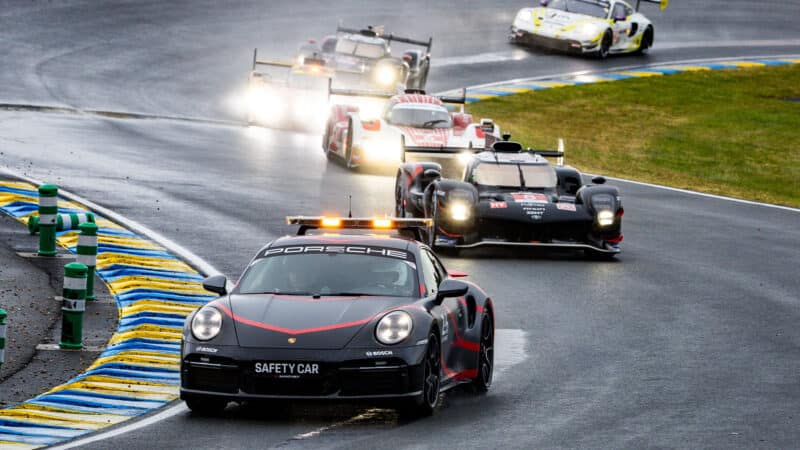
Long safety car periods dominated the race
DPPI
That promoted the No8 Toyota into the lead with Ryo Hirakawa at the wheel, ahead of the No6 Porsche and No7 Toyota, with the No50 Ferrari battling the No2 Cadillac for fourth.
It was relatively settled at the front but the early hours took their toll on the LMP2 and LMGT3 runners.
The No30 Duqueine LMP2 pulled to the side of the Mulsanne Straight with smoke billowing from its air intakes at 11.30pm; No24 Nielsen Racing tangled with a Mustang, putting it out of the fight for class victory, and then the No45 Crowdstrike car lost a rear wheel and retired.
Valentino Rossi had driven his No42 BMW to the front of the LMGT3 category, but it then slipped down the rankings until Ahmad Al Harthy crashed at the Dunlop Chicane just before 1am.
Heavy rain arrived just before 3.30am. The No311 Cadillac span into the gravel and a safety car was called for unsafe conditions.
At least it ensured that anyone catching up on some sleep didn’t miss anything: the safety car period lasted for almost five hours as the rain poured down and rivers formed on he track.
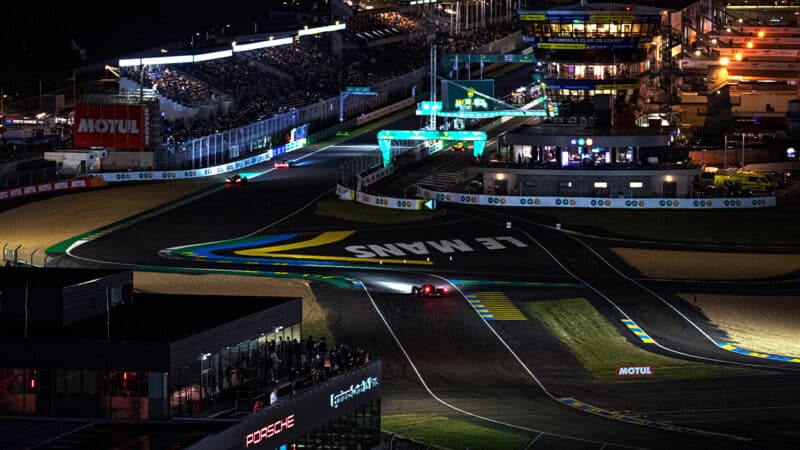
Night period featured much safety car running
Even the safety cars needed refuelling. A fourth car was summoned to relieve each of the three safety cars in turn.
With the various pitstops taken under the safety car, it was the No8 Toyota, which led away at the 8.10am restart, followed closely by the No6 Porsche, No50 Ferrari and No7 Toyota.
Conditions were still wet, as Jenson Button in the No38 Jota Porsche and Matt Campbell in the No5 Porsche slithered in a wheel-to-wheel battle for sixth.
Nyck De Vries in the No7 Toyota was first frontrunner to pit for slicks, just after 9am, and was quickly setting the pace after two laps.
The rest took it as their cue to stop, but the cold tyres — with warmers banned this year — and wet track was unforgiving, as the luckless Felipe Nasr found when he lost the No4 Porsche car at Indianapolis slid through the gravel and hit the barrier: an instant retirement.
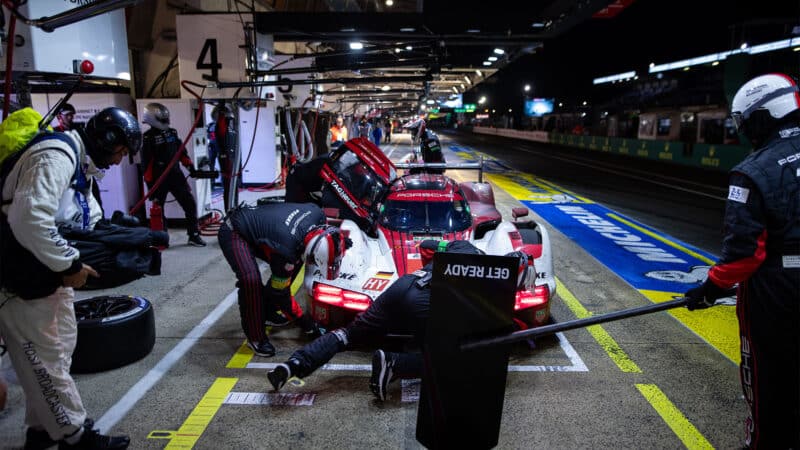
No4 Porsche had a poor race
DPPI
It was already a lap down after clashing with Sarah Bovy in the No85 Iron Dames Lamborghini the previous evening and having to be repaired — as well as serving a penalty. It had suffered a windscreen wiper failure and the crash made it a race to forget for the crew.
Fifteen minutes later, the Indianapolis armco took the brunt of another crash, as Daniel Mancinelli slid wide in the No27 Aston Martin Vantage as he tried to leave space for a Ferrari Hypercar to pass; span and clipped the barrier with the rear and flipped the car.
The safety car call was immediate, but the drama continued as Scott Dixon lost power in the No3 Cadillac and crawled towards the pits, where it appeared to drop oil all over the pitbox. Then the No93 Peugeot of Nico Müller went off after a car twitched in front of him.
He recovered and returned to relative anonymity in the race. Despite an extensive overhaul, this year’s Peugeot 9X8 was less competitive than last year’s car and never looked a threat to any of the main Hypercar contenders.
After another hour of safety car running, the race went green at 9.30am and Earl Bamber led the once-more compressed field across the line in the No2 Cadillac, followed by the No5 Porsche.
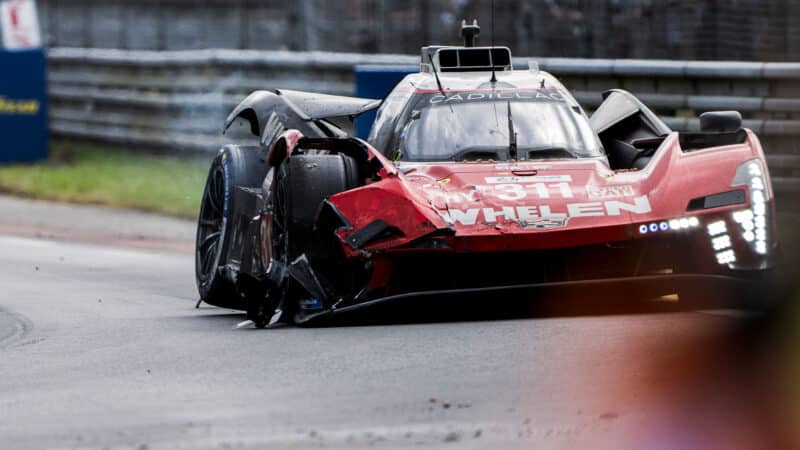
Pipo Derani somehow dragged his damaged Cadillac back to the pits
DPPI
The No83 and No50 Ferraris resumed their battle for third and were joined by the No7 Toyota, spectacularly running three wide down towards Indianapolis.
The No311 Cadillac went off track again after it snapped, Derani lost it and skidded into a barrier. Despite hefty damage, including a missing rear end and angled rear wheel, he recovered the mangled machine to the pits.
With just over five hours remaining, the Toyotas started to show their pace as Buemi in the No8 car passed Estre’s No6 Porsche for sixth place. Ahead, Kobayashi continued harrying the No50 Ferrari before dropping back slightly with high turbo temperatures.
Just 5sec split the top five, although not all were on the same pitstop schedule — the No2 Cadillac and no7 Toyota were pitting halfway through the stints of most other frontrunners.
The American entry had plenty of pace though, Alex Palou setting a pair of fastest laps on low fuel as the morning went on.
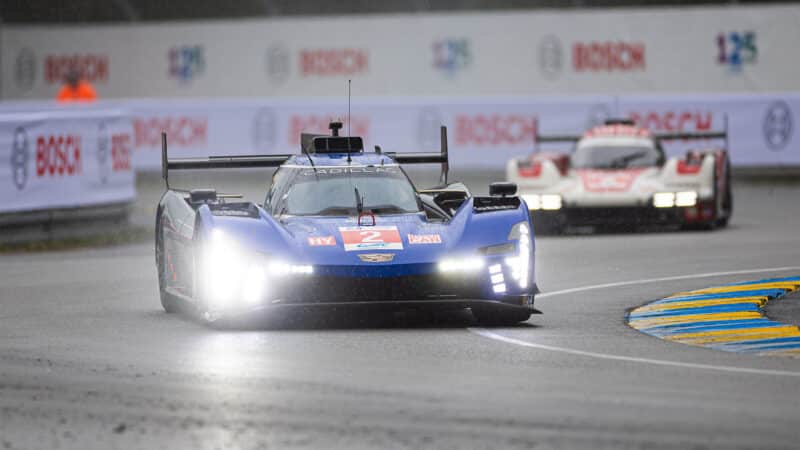
No2 Cadillac had serious pace
DPPI
Ferrari still looked like the team to beat but, with four hours to go, it hit a setback when the customer No83 car pitted and smoke poured from the front right brake ducts. The crew continued servicing the car, but then appeared to spot an issue with the hybrid system.
Yifei Ye — who turned 24 overnight – leapt clear of the car and mechanics wheeled it back into the garage with electric shock-proof gloves.
That still left the No50 and No51 factory cars at the front and its drivers scenting victory. “Let me go!” pleaded Miguel Molina in the No50 car as he pressed the sister machine of James Calado, on older tyres, who moved across to let him past.
There was tyre trouble for Toyota: a puncture for the No7 car forced an early stop, putting it on the same sequence as most rivals — and behind several of them.
The tension was building: the No51 Ferrari and No6 Porsche clattering wheels as they fought for sixth place, with everything still to play for.
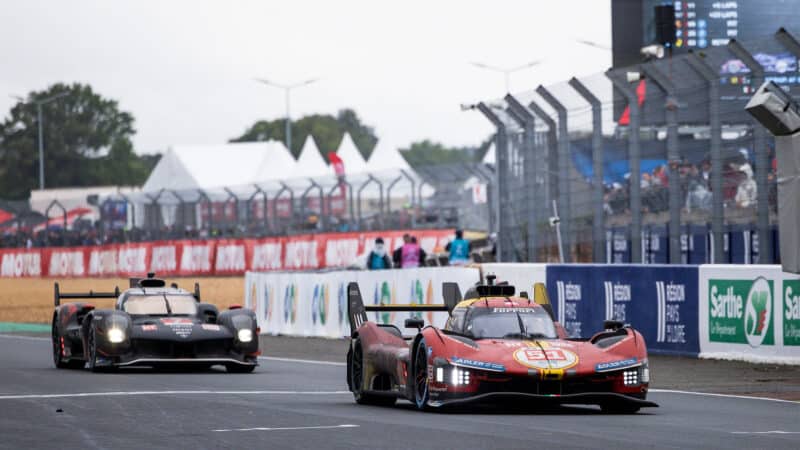
The battle rumbles on
With three hours to go, the No50 Ferrari was leading the No8 Toyota by 7sec. The No51 Ferrari was a further 18sec back, and 2sec ahead of the No6 Porsche; the No7 Toyota was another 7sec back.
It was a long way from over. The rain started falling again and the leaders dived in to the pits for wets. A sticky wheel delayed the No8 Toyota of Brendon Hartley with just over two hours to go and then he was tapped by the No51 Ferrari of Alessandro Pier Guidi as he dived down the inside at Mulsanne Corner to take second.
It brought a 5sec penalty for the No51 car, and dropped Hartley to sixth, but by now Nielsen was putting in searing laps in the No50 Ferrari.
It was the first of the leading cars to make its final pitstop, giving it little in reserve as it raced to the finish, but when thew rest of the contenders stopped, it quickly became that they weren’t contenders after all.
Almost 40sec behind the Ferrari, in the No7 Toyota, Jose Maria Lopez could do nothing about the gap to Nielsen, and his team called off the chase — keen to bring the car back in one piece.
It was left to Nielsen to try and keep going while not using up all of the 499P’s ‘virtual’ energy – he made it back with 2% remaining in a nail-biting finish, his team in agony in the pits during the final moments.

